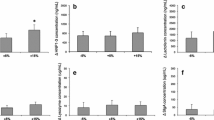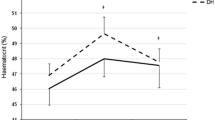Abstract
Introduction
Intracellular lactoferrin (Lac) and lysozyme (Lys) content play an important role in regulating inflammation and promoting host protection. While exercise has demonstrated an increase in Lac and Lys concentration in exocrine solutions, little is known regarding intracellular concentration changes in response to exercise.
Purpose
To quantify intracellular Lac and Lys concentration before and after exercise in salivary CD45+CD15+ cells.
Methods
11 males (20.3 ± 0.8 years, 57.2 ± 7.6 mL/kg/min V̇O2pk, 11.1 ± 3.9% body fat) ran for 45 min at 75% of VO2pk. 12 mL of stimulated saliva were collected pre and immediately post exercise. Saliva was filtered through a 30-µm filter before analysis of leukocytes (CD45+) and granulocytes (CD45+CD15+) using flow cytometry.
Results
Median fluorescent intensity (MFI) of Lac increased from pre (64,268 ± 46,036 MFI) to post (117,134 ± 88,115 MFI) exercise (p <0.05). Lys MFI decreased with exercise (pre: 16,933 ± 8249; post: 11,616 ± 6875) (p <0.05).
Conclusion
Acute running resulted in an increased Lac concentration which could lead to a decrease in inflammation, adding further evidence of the anti-inflammatory effects of exercise. Conversely, the exercise-associated decrease of intracellular Lys content could be the cause of increased Lys in exocrine solutions.


Similar content being viewed by others
Abbreviations
- AMP:
-
Antimicrobial protein
- CD45+ :
-
Leukocytes
- CD45+CD15+ :
-
Granulocytes
- FMO:
-
Fluorescence minus one
- Lac:
-
Lactoferrin
- Lys:
-
Lysozyme
- MFI:
-
Median fluorescent intensity
- OsmolalityRPE:
-
Rating of perceived exertion
- RPMI:
-
Roswell Park Memorial Institute Medium
References
Allgrove J, Gomes E, Hough J, Gleeson M (2008) Effects of exercise intensity on salivary antimicrobial proteins and markers of stress in active men. J Sports Sci 26:653–661
Aps J, Van den Maagdenberg K, Delanghe J, Martens L (2002) Flow cytometry as a new method to quantify the cellular content of human saliva and its relation to gingivitis. Clin Chim Acta 321:35–41. doi:10.1016/S0009-8981(02)00062-1
Borregaard N, Lollike K, Kjeldsen L, Sengeløv H, Bastholm L, Nielsen M, Bainton D (1993) Human neutrophil granules and secretory vesicles. Eur J Haematol 51:187–198. doi:10.1111/j.1600-0609.1993.tb00629.x
Brozek J, Grade R, Anderson J (1963) Densitometric analysis of body composition: revision and some quantitative assumptions. Ann N Y Acad Sci 110:113–140
Cole A, Eastoe J (1988) Biochemistry and oral biology. 2 edn. London
Dos-Santos M et al (2009) Cell phenotyping in saliva of individuals under psychological stress. Cell Immunol 260:39–43. doi:10.1016/j.cellimm.2009.08.002
Garber C et al (2011) Quantity and quality of exercise for developing and maintaining cardiorespiratory, musculoskeletal, and neuromotor fitness in apparently healthy adults: guidance for prescribing exercise. Med Sci Sports Exerc 43:1334–1359
Garre C, Bianchi-Scarra G, Sirito M, Musso M (1992) Lactoferrin binding sites and nuclear localization in K562(S) cells. J Cell Physiol 153:477–182
Gillum T, Kuennen M, Miller T, Riley L (2014) The effects of exercise, sex, and menstrual phase on salivary antimicrobial proteins. Exerc Immunol Rev 20:23–38
Gillum T, Kuennen M, Castillo M, Williams N, Jordan-Patterson A (2015) Exercise, but not acute sleep loss, increases salivary antimicrobial protein secretion. J Strength Cond Res 29:1359–1366. doi:10.1519/jsc.0000000000000828
Gillum T, Kuennen M, McKenna Z, Castillo M, Jordan-Patterson A, Bohnert C (2016) Exercise does not increase salivary lymphocytes, monocytes, or granulocytes, but does increase salivary lysozyme. J Sports Sci:1–6
Gleeson M, Bishop N, Setensel D, Lindley M, Mastana S, Nimmo M (2011) The anti-inflammatory effects of exercise: mechanisms and implications for the prevention and treatment of disease. Nat Rev Immunol 11:607–615
Gordon S, Todd J, Cohn Z (1974) In vitro synthesis and secretion of lysozyme by mononuclear phagocytes. J Exp Med 139:1228–1248
Gordon LSD, Kay N, Yamada O, Osserman E, Jacob H (1979) Modulation of neutrophil function by lysozyme. J Clin Invest 64:226–232
Haversen L, Ohlsson B, Hahn-Zoric M, Hanson L, Mattsby-Baltzer I (2002) Lactoferrin down regulates the LPS-induced cytokine production in monocytic cells via NF-kappa B. Cell Immunol 220:83–95
He J, Furmanske P (1995) Sequence specificity and transcriptional activation in the binding of lactoferrin to DNA. Nature 373:721–724
Lonnerdal B, Iyer S (1995) Lactoferrin: molecular structure and biological function. Annu Rev Nutr 15:93–110
Morozov V, Pryatkin S, Kalinski M, Rogozkin V (2003) Effect of exercise to exhaustion on myeloperoxidase and lysozyme release from blood neutrophils. Eur J Appl Physiol 89:257–262. doi:10.1007/s00421-002-0755-5
Vidovic A, Juras D, Boras V, Lukac J, Grubisic-Ilic M, Rak D, Sabioncello A (2012) Determination of leucocyte subsets in human saliva by flow cytometry. Arch Oral Biol 57:577–583
West N, Pyne D, Renshaw G, Cripps A (2006a) Antimicrobial peptides and proteins, exercise and innate mucosal immunity. FEMS Immunol Med Mircobiol 48:293–304
West NP, Pyne DB, Renshaw GM, Cripps AW (2006b) Antimicrobial peptides and proteins, exercise and innate mucosal immunity. FEMS Immunol Med Mircobiol 48:293–304
West N, Pyne D, Kyd J, Renshaw G, Fricker P, Cripps A (2008) The effect of exercise on innate mucosal immunity. Bri J Sports Med 44:227–231
Acknowledgements
We are grateful to Dave Draper, PhD for his technical support with the flow cytometry design and analysis.
Author information
Authors and Affiliations
Corresponding author
Ethics declarations
Conflict of interest
The authors report no conflict of interest with the present study. The authors alone are responsible for the writing and content of this paper.
Additional information
Communicated by Fabio Fischetti.
An erratum to this article is available at http://dx.doi.org/10.1007/s00421-017-3650-9.
Rights and permissions
About this article
Cite this article
Gillum, T., Kuennen, M., McKenna, Z. et al. Exercise increases lactoferrin, but decreases lysozyme in salivary granulocytes. Eur J Appl Physiol 117, 1047–1051 (2017). https://doi.org/10.1007/s00421-017-3594-0
Received:
Accepted:
Published:
Issue Date:
DOI: https://doi.org/10.1007/s00421-017-3594-0




